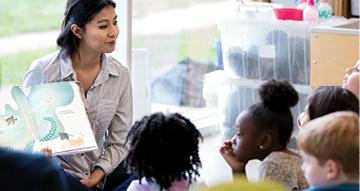As Louisa C. Moats writes in this issue’s cover article, “the most fundamental responsibility of schools is teaching students to read.” Fortunately, there is now a strong research base to guide literacy instruction—but relatively few teacher preparation programs, curricula, or other resources intended to support teachers currently build on that research. Today, about 20 percent of elementary school students across the country struggle with learning to read, and another 20 percent are not meeting grade-level expectations in reading. But these nationwide averages mask a tragedy: among students growing up in underresourced communities—mainly African American and Hispanic students and students whose home language is not English—about 60 to 70 percent have weak reading skills. This issue can largely be addressed now and avoided in the future. The current science of reading is complex, requiring high-quality materials and focused instruction over several years. But results are heartening, with all but about 5 percent of children learning to read well.
In summarizing that science, Moats presents a conceptual model known as the Simple View of Reading, which “states that reading comprehension is the product of word recognition and language comprehension. Without strong skills in either domain, an individual’s reading comprehension will be compromised.” Share My Lesson has resources to help.
Here, we highlight materials created by the Florida Center for Reading Research, an interdisciplinary research center at Florida State University that has nearly 40 resources available through Share My Lesson.
Word Recognition
To develop word recognition, phonological awareness is essential. One resource from the Center suggests using a picture slide so students can segment and blend phonemes (speech sounds) in words. Another activity engages children in practicing phoneme segmenting and blending; it uses Elkonin Box picture cards—as children say what they see in the picture, e.g. fish, they place a token in a box for each phoneme they hear.
Playing with language is also fun with the Center’s “Treasure Chest” game, in which students take turns segmenting words into phonemes and blending them to use as clues. Another enjoyable activity is “Brown Bag It” in which children match initial phonemes to graphemes (letters and letter combinations that represent phonemes/sounds) by sorting pictures based on initial sounds into 26 paper bags labeled with each letter of the alphabet.
Language Comprehension
While learning to sound out words is essential, comprehension relies on much more—like academic knowledge, vocabulary, and familiarity with complex sentence structures. The Center offers several resources to support students in strengthening language comprehension.
For example, in the “Classifying Info” activity students write words or phrases in a graphic organizer that describe and/or relate to a category of a topic based on an expository text. One graphic organizer the Center recommends to help students monitor their understanding is a K-W-L chart. In three separate columns, students keep track of what they already know about a text (K), what they would like to learn (W), and what they learned after reading the text (L).
Another activity the Center suggests is a “Classic Classifying” graphic organizer, in which students write at least four words or phrases that describe and/or relate to a category of a topic. For instance, if the text is about a lion, students could create categories such as “food,” “home,” “appearance,” and “behavior,” and thus keep track of what they learn. Finally, “Expository Exploration,” is another of the Center’s activities in which students create a graphic organizer to help them examine and identify a text’s main idea and details.
Teaching students to read so they become lifelong learners—and experience the joy of reading—is of the utmost importance. To see the thousands of other literacy supports Share My Lesson offers, visit our entire collection of lesson plans, resources, and activities. If you have additional ideas or requests, please reach out to us at content@sharemylesson.com.
–THE SHARE MY LESSON TEAM

